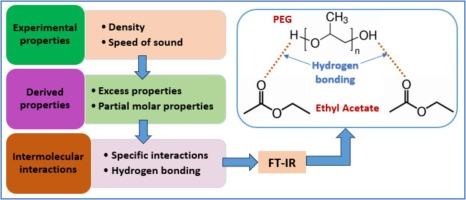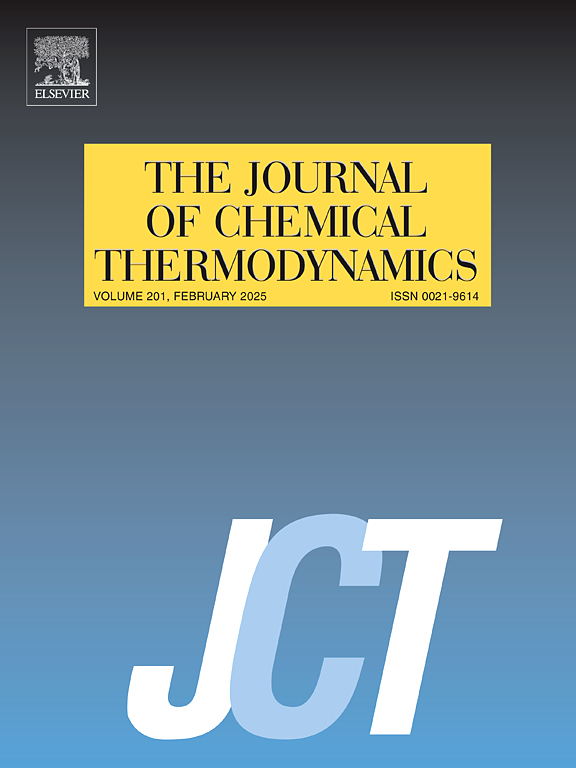利用不同温度下的密度、声速、过量特性和傅立叶变换红外光谱,揭示醋酸乙酯 + 聚乙二醇 200/300/400/600 二元混合物中的分子间相互作用
IF 2.2
3区 工程技术
Q3 CHEMISTRY, PHYSICAL
引用次数: 0
摘要
通过过量和部分摩尔特性以及傅立叶变换红外光谱,研究了醋酸乙酯 + 聚乙二醇(PEG)混合物中的分子间相互作用。在温度为 293.15 K 至 323.15 K 和压力为 p = 100 kPa 的整个组成范围内,对醋酸乙酯 + 聚乙二醇(PEG 200、PEG 300、PEG 400 和 PEG 600)二元混合物的密度和声速进行了测量。ρ 和 u 数据用于计算过量特性,即过量摩尔体积、过量等熵压缩性、过量分子间自由长度、过量声速和过量摩尔等熵压缩性。此外,还计算了各组分在整个成分范围内和无限稀释时的部分摩尔体积/压缩性、过量部分摩尔体积/压缩性。根据这些混合物中现有的分子间相互作用,对这些特性随成分和温度的变化进行了分析。在这些混合物中,乙酸乙酯与 PEG 之间的相互作用顺序如下:PEG 600 > PEG 400 > PEG 300 > PEG 200。利用缩放粒子理论对声速进行了理论估算,并与实验值进行了比较。此外,还记录并分析了纯乙酸乙酯、PEG 200 及其等摩尔混合物的傅立叶变换红外光谱,以确认分子间的相互作用。本文章由计算机程序翻译,如有差异,请以英文原文为准。

Unveiling the intermolecular interactions in ethyl acetate + polyethylene glycol 200/300/400/600 binary mixtures by using densities, speeds of sound, excess properties and FTIR spectra at different temperatures
The intermolecular interactions in ethyl acetate + polyethylene glycols (PEG) mixtures were examined by means of the excess and partial molar properties and FTIR spectra. The measurements of density and speed of sound of ethyl acetate + polyethylene glycols (PEG 200, PEG 300, PEG 400 and PEG 600) binary mixtures have been carried out over whole composition range at temperature from 293.15 K to 323.15 K and pressure, p = 100 kPa. The ρ and u data have been used to calculate excess properties, viz., excess molar volume, excess isentropic compressibility, excess intermolecular free length, excess speed of sound and excess molar isentropic compressibility. In addition, the partial molar volume/compressibility; excess partial molar volume/compressibility of the components over the entire composition range, and at infinite dilution have also been calculated. The variations in these properties with composition and temperature have been conversed in terms of existing intermolecular interactions in these mixtures. The ethyl acetate-PEG interactions in these mixtures follow the order: PEG 600 > PEG 400 > PEG 300 > PEG 200. The speeds of sound were estimated theoretically by using the scaled particle theory and were compared with the experimental values. Furthermore, FT-IR spectra of pure ethyl acetate, PEG 200 and their equimolar mixture were also recorded and analysed to confirm the prevailing intermolecular interactions.
求助全文
通过发布文献求助,成功后即可免费获取论文全文。
去求助
来源期刊

Journal of Chemical Thermodynamics
工程技术-热力学
CiteScore
5.60
自引率
15.40%
发文量
199
审稿时长
79 days
期刊介绍:
The Journal of Chemical Thermodynamics exists primarily for dissemination of significant new knowledge in experimental equilibrium thermodynamics and transport properties of chemical systems. The defining attributes of The Journal are the quality and relevance of the papers published.
The Journal publishes work relating to gases, liquids, solids, polymers, mixtures, solutions and interfaces. Studies on systems with variability, such as biological or bio-based materials, gas hydrates, among others, will also be considered provided these are well characterized and reproducible where possible. Experimental methods should be described in sufficient detail to allow critical assessment of the accuracy claimed.
Authors are encouraged to provide physical or chemical interpretations of the results. Articles can contain modelling sections providing representations of data or molecular insights into the properties or transformations studied. Theoretical papers on chemical thermodynamics using molecular theory or modelling are also considered.
The Journal welcomes review articles in the field of chemical thermodynamics but prospective authors should first consult one of the Editors concerning the suitability of the proposed review.
Contributions of a routine nature or reporting on uncharacterised materials are not accepted.
 求助内容:
求助内容: 应助结果提醒方式:
应助结果提醒方式:


